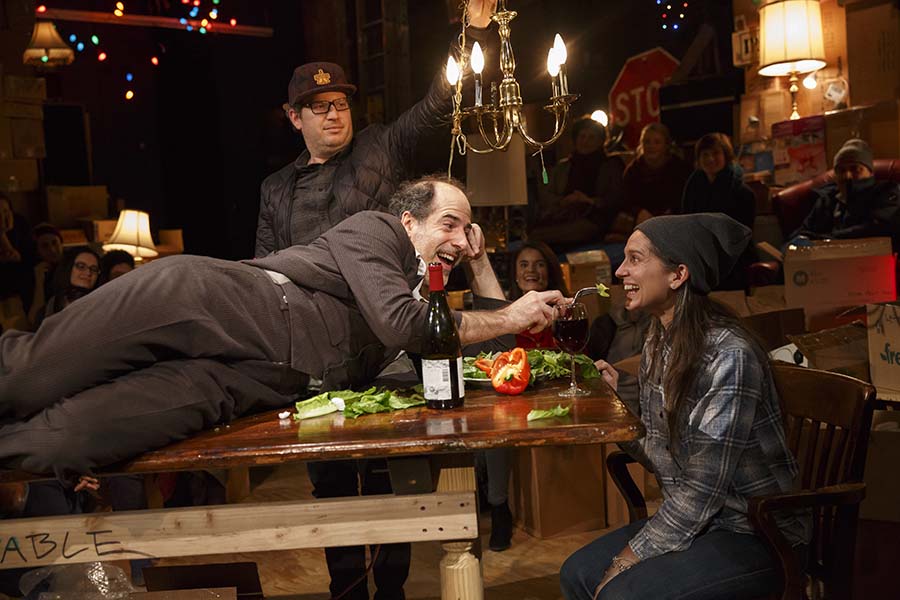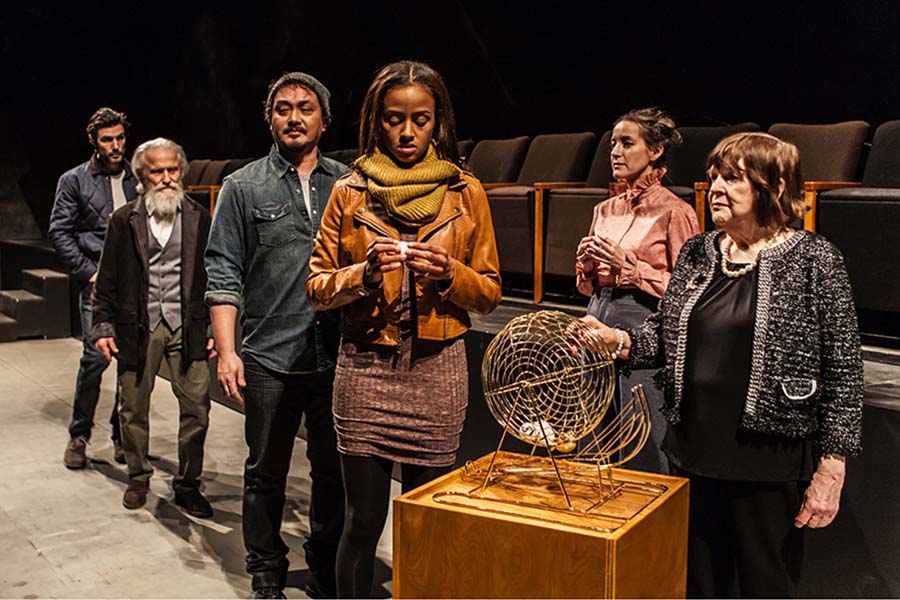Imagine yourself as an actor preparing to make your entrance—except you don’t know what role you’re going to play or who your scene partners will be. This is the reality for the cast of Branden Jacobs-Jenkins’s Everybody, in which five performers pick their role for the evening via lottery. The play, running at Signature Theatre Company in New York City Jan. 31-March 19, is one of many recent shows that are riddled with variables that challenge both cast and audience members.
White Rabbit Red Rabbit, which closed in December at New York’s Westside Theatre, eschews rehearsal or even familiarity with the script, instead thrusting a performer onstage, leaving them with only a hard copy of the script and their instincts to keep the play afloat. Nick Kroll and John Mulaney’s Oh, Hello, which played on Broadway in the fall, relied heavily on improv, comedic timing, a new special guest in the “Too Much Tuna” skit every night—and any unlucky rube who tried to sneak in during the late seating break—all as fodder to build an evening of hysterics. Even Drunk Shakespeare, in an open run at the Lounge in midtown Manhattan, and Drunkle Vanya, at Tolstoy’s Lounge in midtown, have a different cast member hitting the bottle at each performance. Audiences at these shows never know what they’re going to get, and actors can only prepare so much for their ever-changing roles.
Creators of these pieces—let’s call them “variable theatre,” as each possesses a different variable that changes the performance from night to night—insist that there’s nothing groundbreaking about what they’re putting forth. Kroll and Mulaney cite nearly a century’s worth of comedians before them as those who carved out this style of performance.
“What we’re doing is basically vaudeville,” explains Kroll. “Performers would have a big bucket of jokes that they would go out with but then were open to finding new moments of discovery onstage. Vaudeville, Nichols and May, Brooks and Reiner—those were huge influences on the kind of rhythms and jokes in Oh, Hello.”
Creator and performer Geoff Sobelle, whose show The Object Lesson runs Jan. 31-March 19 at New York Theatre Workshop, also rejects the notion that his show is part of a trend. “I think that there is another trend: an expectation that one should enter a room, sit in a comfy seat, listen to some innocuous music, and read a program while passively waiting for a show to start,” he says. “And I have little interest in this particular trend. It feels dull.” Sobelle advocates for increased audience engagement and a complete and total breakdown of the fourth wall.
In The Object Lesson, Sobelle interacts with audience members throughout the show, bringing someone onstage to be his dinner date and even having two attendees take items out of their bags and rank them according to their value.

While shows with audience interaction and changing casts aren’t new, they certainly seem to be getting produced more frequently. Why is that? Lakisha Michelle May, who stars in Everybody, ventures, “I think creators are finding it necessary to highlight that theatre is a live and communal art form.”
Kroll and Mulaney also offer similar theories as to why audiences are searching for unique theatrical experiences. “Our goal was to make people feel like what was happening during that show on that night was specific to them,” Kroll says. “And I think that that is what makes theatre exciting and keeps it interesting. People aren’t on cruise control.”
Most artists don’t want passive audiences, and thus strive to create a communal and reciprocal energy in a room. David Neumann, director of The Object Lesson, says, “The flow of [The Object Lesson] relies on how Geoff and the audience are relating on any given night. We were always interested in giving over a fair amount of that control to see how the room would resonate differently. It’s been a terrifying and gratifying process all at once. The risk of failure is its own catalyst and source of inspiration.”
These shows definitely keep things interesting for the actor. Performers must stay on their toes at all times to control the flow of the piece and build on the ever-changing landscape of the work. “On a good day it’s liberating,” says May. “It’s a good day when I remind myself that the beauty of life is that each moment is full of unlimited unpredictable possibilities.”
It also affords the performer license to have more fun. Mulaney has specific memories of each performance of Oh, Hello. “They’re all pretty distinct to me,” he says. “[Nick and I] can remember them because we had that guest that night. To have that feeling of freshness eight shows a week was invaluable to us.”
Maybe everyone could learn a little bit from improvisation’s “yes, and…” philosophy. When audiences are willing to help performers build a work, great and utterly singular things can happen. Though it may be tempting to envy what last night’s audience saw, wonder if tomorrow’s performance will be more engaging, or fall back into the old pattern of being a passive observer, reveling in the originality of these moments is what makes variable theatre so successful and unique. After all, the most important and unpredictable variables are always people.


